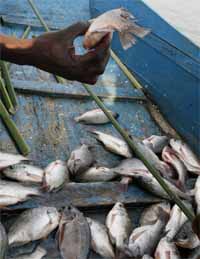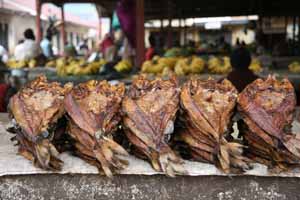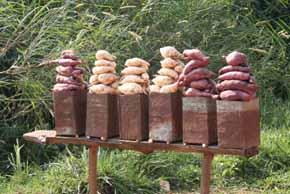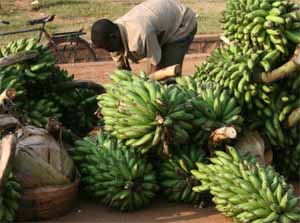Articles
07 July 2007
Uganda's food
The matoke or matooke, is the national dish of Uganda and one of the most ancient of the world. The legend says that it was brought to the Earth by Kintu, the first man.
The medium-sized green bananas are locally known as "matoke". They are peeled, wrapped in the plant's leaves and set in a cooking pot (sufuria) on the stalks which have been removed from the leaves. The pot is then placed on a charcoal fire and the matoke is steamed for a couple of hours in water placed in the bottom of the cooking pot.
While uncooked, the matoke is white and fairly hard. Cooking turns it soft and yellow. The matoke is then mashed while still wrapped in the leaves and often served on a fresh leaf. It is then eaten with a sauce made of vegetables, groundnut sauce or some type of meat (goat and beef are common).
In southern Uganda and especially in Buganda (Kampala, Masaka ...) the cusine consists of Matooke and 'luwombo' = to delicious stew (chicken, beef or Groundnuts) steamed in banana leaves.
Uganda is predominantely agriciltural country and the food is good
Besides matooke, the cuisine of Uganda consists of traditional cooking with English, Arab and Asian (especially Indian) influences. Like the cuisines of most countries, it varies in complexity, from the most basic popular dish to the refined and more complexe several-course meals served in upper-class homes and high-end restaurants.
Most people, except a few who live in urban centers, produce their own food. Meals are prepared by women and girls and cooking usually is done on an open wood fire
Breakfast is often a cup of tea, ugali porridge or Mandazi, a kind of donuts.
Main dishes are usually centered on a sauce or stew of groundnuts, beans or meat. The starch traditionally comes from ugali (maize meal) or matoke, in the South, or an ugali made from millet in the North.
Cassava, yam and African sweet potato are also eaten; the more affluent include white or "Irish" potato and rice in their diets. Soybean was promoted as a healthy food staple in the 1970s and this is also used, especially for breakfast. Chapati, an Asian flatbread, is also part of Ugandan cuisine. Amaranth (dodo), nakati, and borr are examples of regional greens.
Chicken, fish (usually fresh, but there is also a dried variety, reconstituted for stewing), beef, goat and mutton are all commonly eaten, although among the rural poor there would have to be a good reason for slaughtering a large animal such as a goat or a cow and nyama, (Swahili word for "meat") would not be eaten every day.
Fruits like oranges, papayas, lemons, pineapples….are plentiful and regularly eaten, as in the Western World, as snacks or dessert. Europeans introduced cake and this is also popular.
Usuallu people have two meals a day but, if possible, some snacks are anytime welcome:
-roasted groundnuts served in a spill of paper.
-samusa (samousa, samosa) -- Indian samosas have been completely assimilated into the local cuisine, as have chapati and curry.
-mkate na mayai (bread and eggs). Originally an Arab dish, it's wheat dough spread into a thin pancake, filled with minced meat and raw egg, and then folded into a neat parcel and fried on a hotplate.
-nsenene is an unusual food item: a seasonal delicacy of a type of grasshopper, deep fried and salted.
-nswaa served similarly to nsenene but made of white ant
Beverages
Both traditional and western beers are probably the most widely available alcoholic beverage across Uganda. Pombe is the generic word for locally made fermented beer, usually from banana or millet.
Tea (chai) and coffee (kawa) are popular beverages and important cash crops. These can be served English-style or spiced (chai masala).
Coca-cola, Pepsi and Fanta all made inroads in the Ugandan market and soda became very popular.
Waragi, a banana gin, is popular among visitors as a cocktail base.
Uganda is known as The Pearl of Africa due to the great natural beauty: abundant wild fauna including mountain gorillas and excellent tropical climate, make visit very attractive. This country has the privilege of a diverse landscape: numerous lakes, sabana, impressive mountains that reach five thousand meters of height, semidesert to the north of the country and leafy jungles in the south.
In Uganda, when a meal is ready, all the members of the household wash their hands and sit on floor mats. Visitors who drop in are expected to join the family at a meal..
Are you willing to try it?
Laura Gosalbo
July 2007

Fishing in Lake Victoria

Vegetables and fruits market

Dry fish from Lake Victoria

Potatoes for sale

Matooke market
> BackThe medium-sized green bananas are locally known as "matoke". They are peeled, wrapped in the plant's leaves and set in a cooking pot (sufuria) on the stalks which have been removed from the leaves. The pot is then placed on a charcoal fire and the matoke is steamed for a couple of hours in water placed in the bottom of the cooking pot.
While uncooked, the matoke is white and fairly hard. Cooking turns it soft and yellow. The matoke is then mashed while still wrapped in the leaves and often served on a fresh leaf. It is then eaten with a sauce made of vegetables, groundnut sauce or some type of meat (goat and beef are common).
In southern Uganda and especially in Buganda (Kampala, Masaka ...) the cusine consists of Matooke and 'luwombo' = to delicious stew (chicken, beef or Groundnuts) steamed in banana leaves.
Uganda is predominantely agriciltural country and the food is good
Besides matooke, the cuisine of Uganda consists of traditional cooking with English, Arab and Asian (especially Indian) influences. Like the cuisines of most countries, it varies in complexity, from the most basic popular dish to the refined and more complexe several-course meals served in upper-class homes and high-end restaurants.
Most people, except a few who live in urban centers, produce their own food. Meals are prepared by women and girls and cooking usually is done on an open wood fire
Breakfast is often a cup of tea, ugali porridge or Mandazi, a kind of donuts.
Main dishes are usually centered on a sauce or stew of groundnuts, beans or meat. The starch traditionally comes from ugali (maize meal) or matoke, in the South, or an ugali made from millet in the North.
Cassava, yam and African sweet potato are also eaten; the more affluent include white or "Irish" potato and rice in their diets. Soybean was promoted as a healthy food staple in the 1970s and this is also used, especially for breakfast. Chapati, an Asian flatbread, is also part of Ugandan cuisine. Amaranth (dodo), nakati, and borr are examples of regional greens.
Chicken, fish (usually fresh, but there is also a dried variety, reconstituted for stewing), beef, goat and mutton are all commonly eaten, although among the rural poor there would have to be a good reason for slaughtering a large animal such as a goat or a cow and nyama, (Swahili word for "meat") would not be eaten every day.
Fruits like oranges, papayas, lemons, pineapples….are plentiful and regularly eaten, as in the Western World, as snacks or dessert. Europeans introduced cake and this is also popular.
Usuallu people have two meals a day but, if possible, some snacks are anytime welcome:
-roasted groundnuts served in a spill of paper.
-samusa (samousa, samosa) -- Indian samosas have been completely assimilated into the local cuisine, as have chapati and curry.
-mkate na mayai (bread and eggs). Originally an Arab dish, it's wheat dough spread into a thin pancake, filled with minced meat and raw egg, and then folded into a neat parcel and fried on a hotplate.
-nsenene is an unusual food item: a seasonal delicacy of a type of grasshopper, deep fried and salted.
-nswaa served similarly to nsenene but made of white ant
Beverages
Both traditional and western beers are probably the most widely available alcoholic beverage across Uganda. Pombe is the generic word for locally made fermented beer, usually from banana or millet.
Tea (chai) and coffee (kawa) are popular beverages and important cash crops. These can be served English-style or spiced (chai masala).
Coca-cola, Pepsi and Fanta all made inroads in the Ugandan market and soda became very popular.
Waragi, a banana gin, is popular among visitors as a cocktail base.
Uganda is known as The Pearl of Africa due to the great natural beauty: abundant wild fauna including mountain gorillas and excellent tropical climate, make visit very attractive. This country has the privilege of a diverse landscape: numerous lakes, sabana, impressive mountains that reach five thousand meters of height, semidesert to the north of the country and leafy jungles in the south.
In Uganda, when a meal is ready, all the members of the household wash their hands and sit on floor mats. Visitors who drop in are expected to join the family at a meal..
Are you willing to try it?
Laura Gosalbo
July 2007

Fishing in Lake Victoria

Vegetables and fruits market

Dry fish from Lake Victoria

Potatoes for sale

Matooke market





